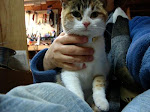Lenses form an image through the operation of refraction; pinholes form an image by diffraction (which lenses want to avoid). A well made pinhole cannot form an image as sharp as a good lens but it is nearly the equal of the optical system composing the human eye. It has many advantages including cost (nearly free), no maintenance, perfectly rectilinear and nearly infinite depth of field as well as depth of focus (behind the pinhole, i.e., inside the camera). A wide angle 8x10 inch pinhole camera made of cardboard might cost as much as $10 - whereas an 8x10 camera with a wide angle lens is likely to start at about $3,000.
Mr. Fuzzy probably has close to a dozen pinhole cameras or adapters, made by friends as gifts, made by friends as prototypes to be tested, commercial products and those made by Himself. There are several 8x10 cameras, adapters to use on standard view cameras of various sizes, adapters for 35mm cameras & digital equivalents, a 5x7 camera made by Mr. Fuzzy (a real favorite), several 4x5 cameras and several 6x9 cm cameras. The latter use 120 roll film and allow six exposures without reloading - that plus easy portability caused Mr. Fuzzy to opt for two of them for World Wide Pinhole Day, always the last Sunday in May.
WWPD is a remarkable event: world wide, unjuried, free, and the images are posted forever on the WWPD web site (www.pinholeday.org). Most of the images therein are rather pedestrian but perhaps 1 in 100 makes your search worthwhile.
Mr. Fuzzy made this image with a curved film plane 6x9 camera which covers a very wide angle, perhaps 120 degrees. The lower portion of the image is about 18 inches from the camera.
The following image is also 6x9 cm but the film plane is flat thus it covers a much smaller angle and is about a normal angle, or 45 degrees. This image is not as sharp as the one above because the pinhole I made is not as perfect as it might be. This camera was made by a dear friend in Scotland, Peter Goldsmith, and it has been a pleasure to use for almost a decade. Peter, thanks again for the wonderful gift!
Mr. Fuzzy gave a short lecture to a class at the local arts centre immediately preceding WWPD. The students are so excited that they have asked the arts centre to provide space for a pinhole club to meet - and the answer from the director was in the affirmative. A pinhole camera club will be formed forthwith!







3 comments:
Would love to see you demonstrate this if we find our way back to your neck of the woods.
Hello,
If "Mr Fuzzy" is Dr. Russ Young III, then I must comment that you are one hard person to locate. With help from the Ransom Collection, I found this location. Of course, once I found the Strathenden Farm and the delightfully spooky images, I thought "Ah Ha! Maybe this is my missing photographer." I remember your mentioning West Virginia, and I thought perhaps an academic location. Farmsteading is a familiar activity, as this is what I was doing when a barn fell on me and threw me into photography and a return to History of Religions (for which I now have 3 degrees. If this is indeed THE Russ Young of Santa Fe, with whom we attempted some calotyping, and to whom I owe a salted paper print from a large-format calotype, please reply with your address. I too have moved: my back broke in 2008, so I moved into a housing-apartment for disabled: 200 Conifer Drive #3009, Ithaca, NY 14850. Tel: 607-272-9050.
Thank you.
Rev, Dr Christopher A Wright BA, MA, PhD, Dr. Div.
Consultant: Getty Museum's Project to preserve the
Traditional Chemical/Wet Darkroom;
Historic Photographer/Instructor: Calotypy,
Collodion, Silver Gelatin negatives; Salted/
Albumen Paper Prints; Non-Silver/"Alternative"
Photographic Prints; Split-toned Silver Prints;
Lecturer, History and Art of Photography: Keuka
College, Rochester Institute of Technology,
Otterbein College, Ansel Adams Workshop,
Artmont School of Arts and Crafts, Cornell
University, U. of Florida, (Gainesville);
Owner: Visions in Silver Photography: Portraits
(Maternity, Children, Family, Individuals);
Landscape, Still-Life; Abstracts; prints from
antique glass negatives;
Independent Researcher, Scholar, Writer on earliest
photographic processes;
Recipient of Grants/Fellowships:
(3) New York State Council on the Arts;
(3) New York State Fellowship for the Arts;
(1) National Endowment for the Humanities;
Buyer-seller of Photographica on eBay, 1997-
present;
2011: Still Life-- Still Living; personal photographs
in various processes by the artist, with essays
describing spiritually-based aesthetics;printed/
published by Visions in Silver Photography,
Ithaca, NY 2011;
2013: Darkroom-friendly manual on making
calotypes: Modern Calotypy: Ancient Ways --
Modern Views.
Internet Preview, Ch 1
http://www.alternativephotography.com/wp/processes/calotypes/ancient-ways-modern-views
1979- : Independent Researcher/Scholar in History
of Religions: MesoAmerican Iconography;
Western mysticism; early Jewish-and Gentile-
Christian sects post-destruction of Second
Temple;
Ritual Use of Sacred Plants in World Religions;
Independent Scholar for Graduate School,
Department of Religion, U of Fl., Gainesville;
2011: Presenter for Symposium on use of Ritual
Plants in Study of Religions; use of cannabis in
ancient Israel, early Jewish/Gentile-Christian
sects; U of Fl., Gainesville;
2013: 15+ page article for Encyclopedia on Sacred
and Medicinal Plants, inclusion in e-
encyclopedia about healing, religious uses of
sacred flora;
2013: Awarded Dr. Of Divinity, Universal Free Life
Monastery, thesis on entheogenic origins of
Middle Eastern religions, Israel and early Xnty.
Love these images. I am going to HAVE to come down to learn how to do this. Thanks for sharing them.
Post a Comment